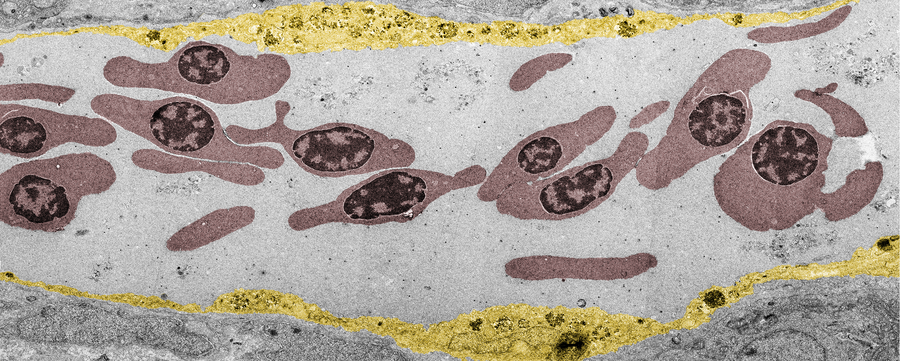Oct 1 2020
When nanoparticles are injected into the bloodstream, for instance, to kill solid tumors, it is not known what exactly happens to them.
 Pseudo-colored electron micrograph depicting nanoparticles circulating in the bloodstream along with red blood cells (red) and those sequestered in endothelial cells lining the blood vessel (yellow). Image Credit: Yuya Hayashi.
Pseudo-colored electron micrograph depicting nanoparticles circulating in the bloodstream along with red blood cells (red) and those sequestered in endothelial cells lining the blood vessel (yellow). Image Credit: Yuya Hayashi.
Now, with new results reported in the ACS Nano journal, scientists from Aarhus University are set to deal with this challenging query by using zebrafish embryos as a new research model in nanotoxicology and nanomedicine.
A wide range of nanoparticles are engineered for targeted drug delivery, but regrettably, just a few of the injected nanoparticles reach the site of target, such as solid tumors. The reason for this low targeting efficiency is frequently considered a “black box” and thus had not been investigated thoroughly for a number of years.
An international research group, headed by Yuya Hayashi from the Department of Molecular Biology and Genetics (MBG), Aarhus University, has now shown the beauty of zebrafish embryos in nano-bioimaging that can view dynamic interactions between nanoparticles and target cells in a living entity.
Currently, in association with scientists from Interdisciplinary Nanoscience Center (iNANO), Yuya aims to answer the unexplained mysteries in bionanoscience—the first one is the biological identity concept, which elucidates how cells detect nanoparticles via a “corona” of proteins surrounding each particle.
For the first time, this concept has now been demonstrated in a living organism through the use of zebrafish embryos, revealing what exactly occurs to nanoparticles when they are injected into the blood.
Friend or Foe? How Biological Systems Recognize Nanoparticles
“What the Cell Sees in Bionanoscience” is one of the initial publications that have established how a protein corona develops around a nanoparticle and how this protein corona indicates the need for reconsidering the way one observes nanoparticles within a biological setting. From elaborate research made in the last several years, researchers have now understood that two opposing effects mostly play a role in the cellular uptake of nanoparticles.
Generally, the protein corona inhibits the surface of the nanoparticle from direct physical interactions with the cell membrane. But what if the protein corona sends a signal that activates a particular biological interaction with receptors positioned on the cell membrane? That is something the cell detects and therefore confers a biological identity to the nanoparticle.
Currently, the scientists from Aarhus University have thus given the first “visual” proof for the excellent influence of the protein corona with regard to the clearance of nanoparticles from the blood that involved adverse results in the zebrafish embryo model.
The researchers employed a species-mismatched source of proteins for the formation of corona to produce a “non-self” biological identity and traced the movement of nanoparticles traveling via the blood and to their final target—that is, endolysosomes in the cell.
This showed an unexpectedly quick uptake and acidification of the nanoparticles by scavenger endothelial cells (functional counterpart to the liver sinusoidal endothelial cells in mammals) followed by pro-inflammatory stimulation of macrophages.
It sounds like a crazy idea to inject nanoparticles with proteins from another animal, but for example, biomolecule-inspired nanomedicines are tested in a mouse model without particular concerns for the species-mismatched combination.
Yuya Hayashi, Department of Molecular Biology and Genetics, Aarhus University
Hayashi continued, “Or else some clever folks humanise the mouse to take care of the species compatibility problem. In fact, even at the cell culture level nanoparticles are still routinely tested following the tradition to use serum supplement derived from cows while knowing that nanoparticle-protein interactions are a key driver of cellular uptake.”
What makes this kind of experiments rather challenging is to maximally retain the original protein corona in a living organism. If the pre-formed corona gets quickly exchanged by endogenous blood proteins, the hypothesis tested becomes invalid. We have made quite some efforts to characterise the protein corona to ensure the nanoparticles preserve the non-self-biological identity.
Hossein Mohammad-Beigi, Study First Author, Aarhus University
Seeing is Believing—the Zebrafish Model can Offer What Rodent Models Cannot
The maximum benefit of the zebrafish model is its power in multicolor immediate imaging, whereby numerous combinations of reporter proteins and fluorescence tracers can be viewed in a basic arrangement at high spatio-temporal resolution. This offers a new chance that lies between less lifelike cell culture systems and more complex rodent experiments, like intravital microscopy.
Using cell cultures, we have learnt quite a lot about how cells recognise nanoparticles rather as dynamic aggregates of proteins but it was never tested in a more realistic situation. With establishment of the zebrafish model, we have finally acquired a means to further explore this question in a living organism.
Yuya Hayashi, Department of Molecular Biology and Genetics, Aarhus University
“It was a simple approach with an extreme scenario tested in a very complex system, but I believe we are now one step closer to understanding what the protein corona can really mean to nanoparticles. In an environment rich in proteins, nanoparticles can wear a mask that gives them a biological identity, and its non-selfness can make them a foe. What defines the degree of the non-selfness? Well, it's the next big question we have to address,” Hayashi concluded.
Journal Reference:
Mohammad-Beigi, H., et al. (2020) Tracing the In Vivo Fate of Nanoparticles with a “Non-Self” Biological Identity. ACS Nano. doi.org/10.1021/acsnano.0c05178.